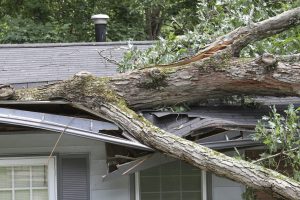
Stress can be caused by many things but, as a first-time homeowner, home repairs have a tendency to be stressful and cause more worry than most people would think. There are so many things that can go wrong with your home from appliances to HVAC, plumbing to electrical. A homeowner can begin to wonder, “What’s coming next?” Major repairs can be very costly. Let’s take a look at the top 10 home repairs that can seriously break the bank.
Water is a major issue when it begins to cause damage to your home. It seeps through concrete, settles in basements, sprouts mold, weakens your foundation and can eventually cause your walls to crack to cause widespread issues throughout your home.
One way to avoid water problems is to control how water flows away from your home during storms and rain showers. Clogged gutters and downspouts can spell trouble if they aren’t properly maintained and cleaned regularly. One sure fire way to alleviate this potential issue is to spend a few hours every week or so clearing out the gutters and doing a spot check on the overall condition of the gutters and downspouts.
HVAC, which stands for heating, ventilation and air conditioning, is another big source for costly home repairs. HVAC, in a joking manner, can also mean “Here’s my Visa And Cash.” But seriously, if you don’t properly maintain your furnace and air conditioning units, you could be facing tremendous repair costs for parts and labor or even replacing the unit completely. A gas furnace can start around $1,000-$2,000 dollars but, for professional installation you could see a cost of around $4,000-$8,000.
The best way to avoid a furnace or air conditioner failure is to conduct maintenance a minimum of every six months. Have an HVAC professional come to your home to run through a checklist that includes lubricating all the moving parts, tightening electrical connections, clearing out the condensate drain in the air conditioner, checking the refrigerant level and cleaning any dirty coils or fixtures. This isn’t a total fail-safe plan but, it sure helps in lengthening the life of your HVAC units.
Water and sewer line maintenance by the town or city you live in ends at the street. Homeowners are responsible for the length of pipe running underneath their property. The cost of physically replacing the water or sewage lines is not the issue – what will really break the bank is the clean-up. Once you have an issue, you will need a crew to come in, excavate your yard and do the necessary repairs. The homeowner will then be tasked with the re-landscaping, possibly re-laying driveways and sidewalks and more – this could mean thousands of dollars going down the drain. A great way to curb this possible issue is to carry water and sewer line insurance and to have your lines inspected annually for an signs of leaks or cracks.
I know many people who either have or want a wooden deck for entertaining and relaxing on the weekend. However, fall short on routine maintenance, and your deck could fall victim to rot or it could fall apart completely. Most decks can be maintained for approximately $100 annually but, replacing your deck could be in the neighborhood of $7,000-$10,000.
To keep your deck healthy, you will want to keep it clean. Each spring, make sure you clean out the leaves and twigs from beneath the floorboards and scrub down all of the wood surfaces with a deck cleaning solution or homemade mix of bleach and water. Once the deck is all clean, apply a fresh coat of stain or a good quality sealant. A sealant keeps the moisture from seeping into the wood and causing rot.
Many homeowners in rural areas have septic tanks. A septic tank works just like the city’s sewage treatment facility, just on the smaller level, by separating the solids and fats from household waste and allowing the leftover liquid to seep into a drainfield where beneficial bacteria complete the process.
Septic systems do require some special care and maintenance that most city folk take for granted. The best plan to keep your septic tank working properly is to have a professional come out and check it annually. Most inspectors will advise that your septic tank be pumped out every three to five years. Not doing so, can cause a huge stinky mess that will cost much more than just paying a professional team to come and and pump the tank clean from time-to-time.
Sure signs of issues with your septic tank can be: backed-up toilets and foul smells in the house, standing water or wet soil in the yard above the tank or a patch of bright green grass above the tank. If any of these signs occur, be sure to call a professional before the problem grows and becomes even more expensive to correct.
An asphalt driveway sure makes it great on rainy days as you dart your way in and out of puddles on the way to your front door or side entrance. However, repairing that driveway can be costly and time consuming.
Driveways take a beating. Not only must they handle the weight of large vehicles, they are also exposed to extreme cold and ice as well as the baking hot sun and rain, day after day, year after year. All of this wear and tear can eventually cause your driveway to crack and buckle. The average cost of having a new asphalt driveway installed is around $5,000 but, you can help preserve your driveway with just a few easy steps.
When the weather is hot and dry, give your driveway a good scrub with a mild mixture of warm water and laundry detergent. Once it dries, apply a layer of driveway sealant. Once applied, the sealant will need approximately 24-48 hours to completely dry and cure. But to save that replacement cost, it’s well worth the wait.
More than one-third of the homes in America rely on a fireplace or wood heater as the primary heat source. Unfortunately, around 36% (thirty-six percent) of house fires in the U.S. are caused by faulty fireplaces which causes millions of dollars worth of damage and sometimes loss of life.
You can protect your family and your home from smoke and fire damage by taking some simple safety precautions. The most important step is to keep your chimney clean. Have a chimney sweep inspect and check your chimney at least once a year. You will also want to make sure the chimney cap – the metal sheet covering the top opening of the chimney – is in place and that there are no birds nests or debris clogging the opening. One sure way to lessen your safety concern if there is an incident with your fireplace or wood stove, is to have a smoke detector (or detectors) and make sure the batteries are charged or changed at least twice a year.
Those beautiful trees on your property can provide lots of pleasure by keeping your home shady and cooler during the summer heat, allowing you to watch the birds that might make a nest there or even allow your children to have a tree house. Nevertheless, trees can be a source of expensive repairs for your home as well.

If left untrimmed, a high wind or storm can blow through and cause limbs to break off or the tree to split and land on your home, break through windows, take out power lines and transformers and also cause damage to your vehicle. Homeowners will want to check their trees regularly for damage or dead branches that can fall as well as the root system to be sure the tree is securely in the ground to prevent falling during high straight-line winds.
There are so many other repairs that need to be around your home but, taking a little time to assess the situation for the above major repairs might just save you some heartache and alleviate the stress on your pocketbook.
What have you done to prepare or protect yourself from expensive repairs? We would love to hear your ideas. Please share in the comment section below.






